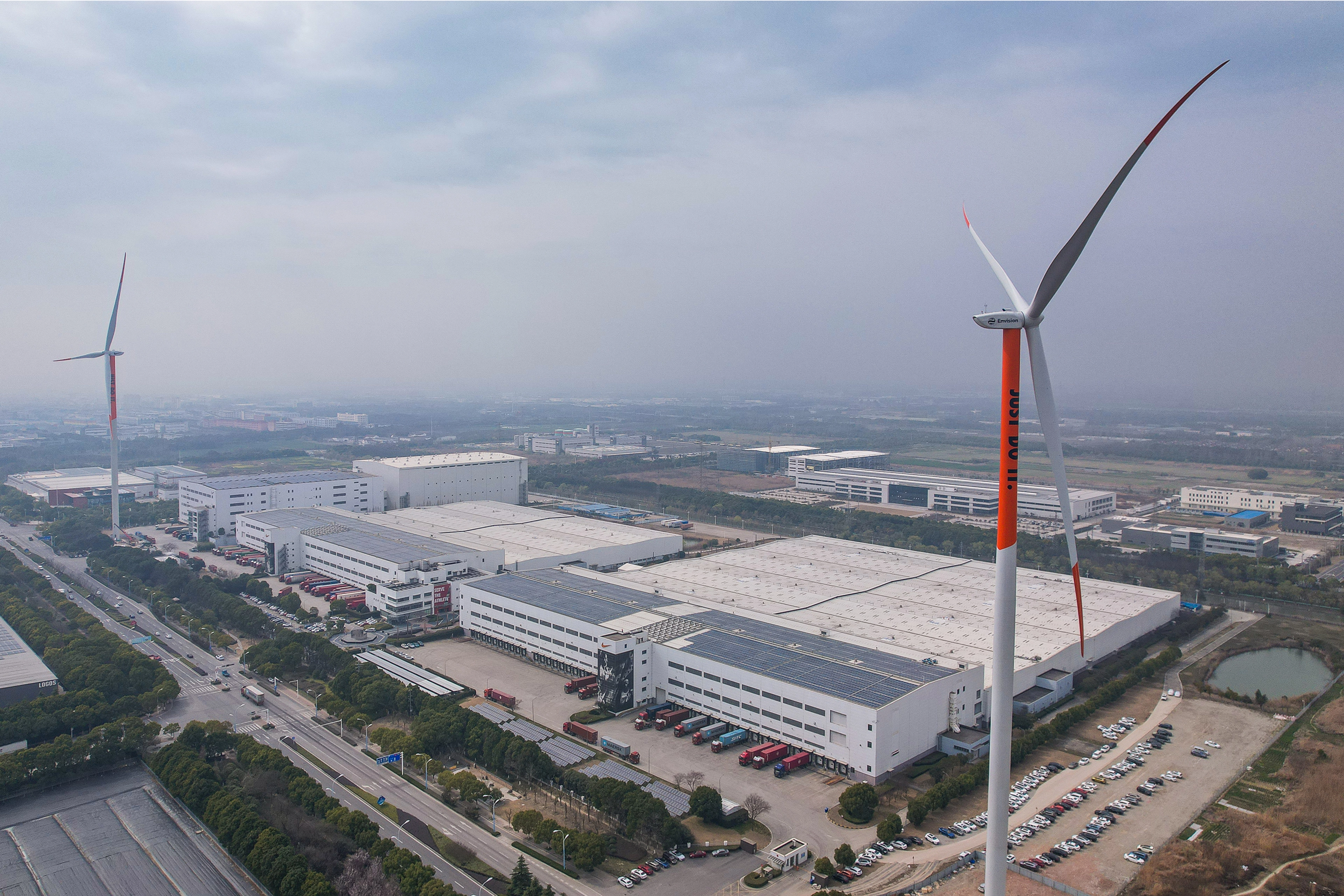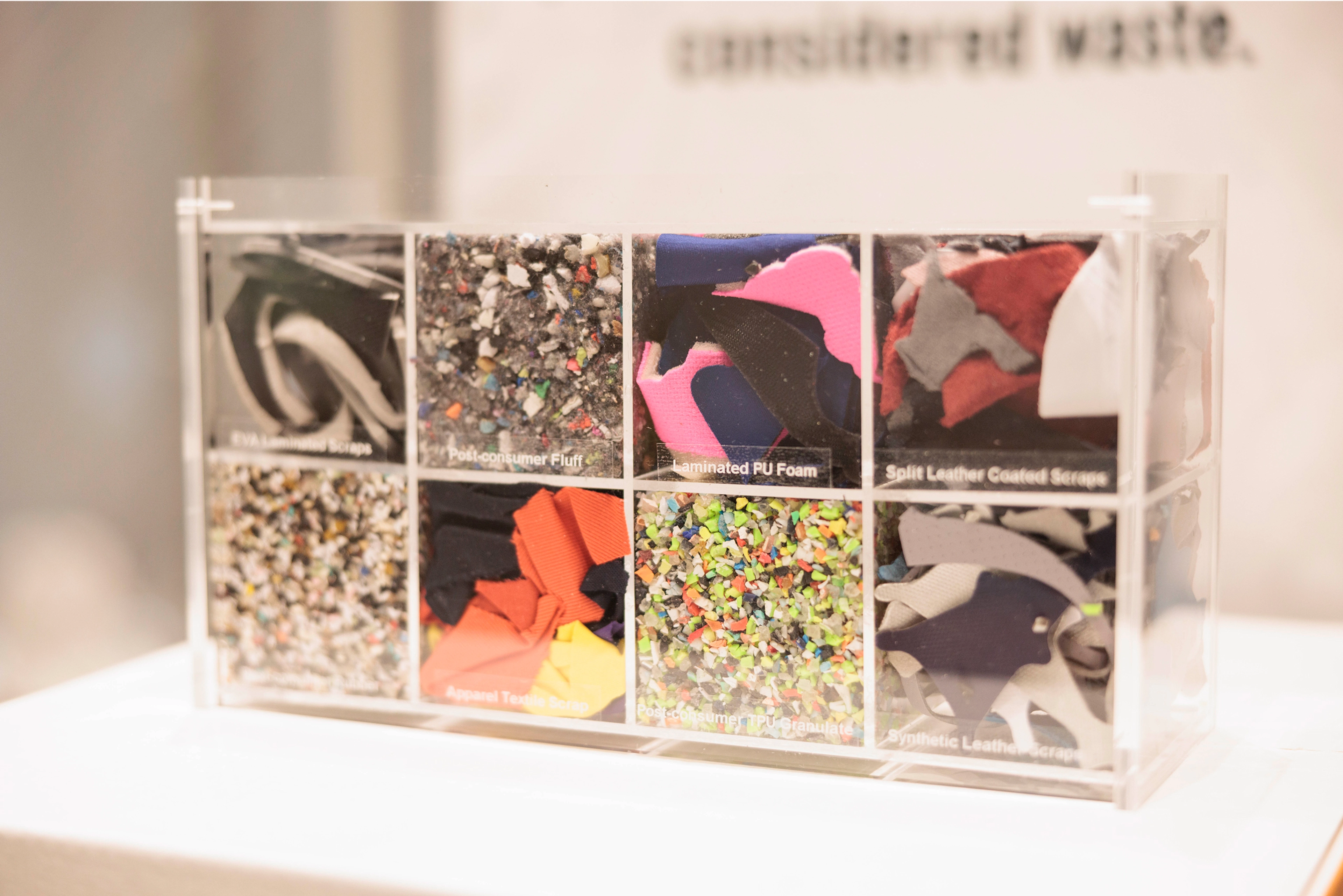Reducing Our Carbon Footprint
NIKE set a science-based target (SBT) in FY19 to reduce our carbon footprint by 2030, including a 65% absolute reduction across our own operations (Scope 1 and 2 emissions) and 30% across our supply chain (Scope 3 emissions) from a 2015 baseline.

At our size and scale, these are ambitious targets. We’ve taken consistent action across the three areas of our business that account for the majority of our emissions:
- Materials used in our products (raw materials represent 34% of our footprint)
- How they are manufactured (materials finishing and materials and product manufacturing are collectively 43% of our footprint)
- The transportation of product from suppliers to distribution centers to consumers (total inbound and outbound transportation is 7% of our footprint)
To achieve our goals, we are focused on innovating and scaling lower-carbon materials and supporting suppliers in their transition to renewable energy. Minimizing air freight and scaling more sustainable fuels are also key to building on the progress we have already made in reducing our transportation footprint. We continue to collaborate pre-competitively with other brands and organizations to multiply impact across our industry and beyond.

Scope 1 and 2 emissions are generated by the roughly 1,000 NIKE-owned and -leased facilities and our corporate vehicle and jet fleets. We have direct control over Scope 1 and 2 emissions and are consistently taking action to reduce emissions in these places. Although small in comparison to our global supply chain footprint, leading with emissions reductions in our own operations plays a critical role in our strategy to reduce greenhouse gas emissions overall.
Scope 3 emissions are generated by our supply chain—a diverse and complex system of finished goods footwear factories, finished goods apparel factories, independent suppliers who source our materials and transportation logistics providers. Though we cannot directly control the operations of these entities, we have built partnerships and trust over decades that influence practices and policies. As a result, as of the end of FY24, NIKE Scope 3 emissions have declined by 29% since 2020. In FY24, more than 60% of NIKE production volume was sourced from suppliers with science-aligned targets for their own Scope 1 and 2 emissions.

In FY24, 34% of our carbon footprint is directly tied to our raw material choices. This is a significant opportunity to lessen our impact without compromising the performance of our products.
We prioritize replacing key materials that have the greatest impact—polyester, cotton, leather, foam and rubber—and are using materials like recycled polyester and lower-carbon leather and continually innovating new solutions. We create new materials, like Nike Flyknit and Nike FlyWeb, to deliver on our promise of performance and sustainability. In FY24, our Textile-to-Textile initiative (converting polyester-based components, such as laces and linings, to closed-loop recycled alternatives) came to life across our portfolio from the 2024 Paris Olympics medal stand, to the global launch of the Pegasus 41, which uses recycled polyester scrap from the Pegasus 38.
In FY24, we reached 96% market-matched renewable electricity coverage for our operations, and we are exploring opportunities to reduce emissions further by transitioning away from natural gas and minimizing impacts from refrigerants. To reduce the impact of our distribution centers, retail stores, offices and transportation fleets, we actively pursue LEED certification, increase solar power generation whenever possible and leverage any action—no matter how small—to increase efficiency.
Across the supply chain, we are focused on helping manufacturing suppliers maximize their use of renewable electricity and engaging with suppliers in policy advocacy to advance that target, with a particular focus on Asia through the Asia Clean Energy Coalition (ACEC), of which NIKE is a founding member.
ACEC brings together clean energy buyers, project developers and financiers to influence policy that mobilizes the expansion of clean energy options across the Asia Pacific Region. Throughout 2024, ACEC took action to influence policies that unlock renewable energy adoption across key Asian markets. For example, ACEC provided technical assistance and feedback on drafts of the Vietnamese government’s proposed DPPA mechanism decree. The coalition also attended meetings to express its support for the immediate implementation of the decree, which facilitate the sale of renewable energy sources to large electricity users. Consequently, the Vietnamese government passed the DPPA decree in July 2024, which will help open up renewable electricity options in our largest manufacturing market.
During FY24, ACEC’s work resulted in stronger renewable energy practices in Vietnam and working groups were established across Singapore, Japan, Indonesia, South Korea and Vietnam to help increase cross-industry renewable energy adoption.
Because coal is a significant source of carbon emissions and air pollution, we continue to work with materials manufacturers on helping to eliminate coal from onsite boilers and are partnering with industry groups to develop and deploy scalable solutions to decarbonize thermal loads. By the end of FY24, 29% of the energy sourced by strategic suppliers was from renewable sources, up from 8% in FY20.

We continue to electrify more of our NIKE-owned fleet and make headway in our corporate jet sustainability program. Today, more than half of Nike's global HQ fleet (160 vehicles) is electric, and we are managing corporate jet energy use by incorporating more energy-efficient jets, as well as increasing procurement of blended sustainable aviation fuel.
Air freight on average produces 40 times more greenhouse gas emissions per unit than ocean freight and is also more costly. NIKE is reducing its use of air freight by aligning production schedules with ocean freight transit times and we have made significant progress toward reducing our reliance on air freight for digital orders. Since 2020, NIKE has reduced the use of air freight from suppliers by nearly 80%.
NIKE is working with transportation vendors to scale the use of alternative fuels and are steadily increasing our use of sustainable biofuel in ocean transportation. In 2023, NIKE partnered with Future Proof Shipping, a Dutch shipping company, hydrogen provider Air Liquide and the BCTN network of inland terminals to launch H₂ Barge 1, the world’s first hydrogen-powered inland container barge. Sailing between Rotterdam in the Netherlands and NIKE’s European Logistics Campus (ELC) in Belgium, the barge emits only humid air and clean water. NIKE has also partnered with Maersk to launch the first shipping vessel in the U.S. to operate on green methanol, an alternative to conventional oil. In FY24, 25% of inbound ocean units were shipped using biofuels.
An updated NIKE Sustainable Fuels Policy establishes sustainable fuel criteria for our providers and aids our teams in selecting fuels that help deliver meaningful reductions to NIKE’s environmental impact. In addition, we are working to scale alternative fuels, especially electrification, for last mile deliveries to stores and customers.
We continue to accelerate change through pre-competitive collaboration. We work within our industry, across sectors and with governments and nongovernmental organizations (NGOs) to advocate for policies that help mitigate climate change and build initiatives, like NIKE’s Supplier Climate Action Program (SCAP). Since FY20, SCAP has brought together some of the largest suppliers in our industry to set ambitious climate targets and share challenges and best practices. In 2024, NIKE worked with Cascale to evolve SCAP into their Manufacturing Climate Action Program, helping expand impact across the industry.